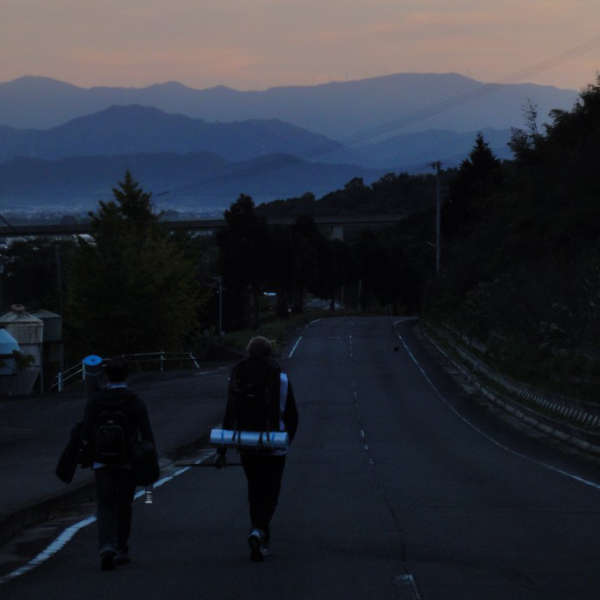Have you heard of the Shikoku Pilgrimage? It is a pilgrimage of 88 temples that are related to the founder of the Shingon school of Japanese Buddhism, Kūkai. Thanks to the research of Ian Reader (2006), the pilgrimage has become more widely known in the West in recent years. This is a Japanese essay on my experience of the Shikoku pilgrimage that I wrote in 2012. A shortened version of this essay appeared in the Shikoku Shimbun newspaper on Dec 24th, 2012. I added a rough English translation of the shortened essay below.
さまざまな国の友達ができ、全国を旅行し、楽しい思い出に満ちた一年間を日本で過ごしてきた。ここでは、僕が関心を寄せる仏教と関連したことを書いてみたい。
四国の遍路について聞いたことがあるだろうか。四国遍路とは、真言宗の開祖である空海にちなんだ八十八箇所を巡る巡礼のことである。お遍路さんは、そのほとんどが中年と年配の日本人だが、時折、外国人も目にする。欧米では、リーダー(2006)の研究により、遍路のことが近年知られるようになってきた。
遍路に出る動機は人によってまちまちだ。僕の場合は、友達の話がきっかけだった。昨年11月のある日、京都の御所を巡った折、ニュージーランドの友達から「来週大学の休みがあるから、四国の遍路に一緒に行ってみないか」と誘われた。その誘いがすごく気に入り、もう一人の友達と三人で行くことに即決した。
11月の四国といえば、段々寒くなり、夜中零度になることもある。「外で寝ることになるかもしれないよ」と注意してもらったものの、実際に最初の夜にそんなことになるとは思いもしなかった。その夜、泊まろうと思っていた民宿に着いたのは10時過ぎだった。電気がもう消えていたので、ベルを鳴らす気にはならなくて、宿の前で寝袋で寝ることにした。その夜は、やはり零度に達した。一睡もできず、翌日の朝を迎えた僕たちの姿に宿主がどんなに驚いたことだろうか。出発しようとしていた僕たちに温かいコーヒーをすすめてくれた。その旅で出会った他の人みんなが僕たちをお遍路さんとして歓迎してくれた。車社会の現代、真摯に巡礼する三人の姿は日本人の目にどのように写ったのだろうか。

休みが短かったので、16番までしか行けなかった。それでも、美しい仏像や日本の田園景色など印象に残っているものが多い。ちなみに、別の夜はきちんと宿泊することができた。しかもすべて無料だった。日本社会には外国人に閉鎖的なところがあるといわれているが、少なくとも四国ではそういったことが感じられなかった。
四国が恋しくてしかたない。仏教には、人を結びつける「ご縁」という語がある。遍路をしているとき、言葉では表現できない不思議な感じがした。まるで今までと空気が違うような感じだった。四国の思い出を大切にし、ぜひ16番から続けてみたいと願っている。その時、新しい自分が見つかるかもしれないと思っている。
In November 2011 when I was visiting the Imperial Palace in Kyoto I bumped into a friend from New Zealand, who asked me whether I wanted to go on the Shikoku pilgrimage the next week when we had no classes. I was excited about the idea, and we spontaneously decided to go there and then, together with a third friend.
Shikoku in November tends to get fairly cold and zero degrees at night are no rarity. Although my friend had warned me that we might well end up sleeping rough, I did not expect that we would indeed have to sleep outside in the cold on our very first night. But that is exactly what happened. That night we arrived at the guest house we had hoped to be able to stay at after ten o’clock, but the lights were already out. Not wanting to wake anyone up, we decided to sleep in front of the house in our sleeping bags. That night the temperature dropped below zero for the first time that autumn. I could not sleep at all. You can imagine how surprised the owner of the guesthouse was when he found us lying in front of his house early the next morning. We were about to depart since we had a long way before us, but he insisted to treat us to some hot coffee. Not only him, but all the people we met on our journey welcomed us as pilgrims and treated us kindly. Many Japanese nowadays do the pilgrimage by bus or car because they have too little time. I wonder what people thought of us, walking in our white pilgrim garbs.
Since our holiday was short, we only made it to temple no. 16. Nonetheless, Shikoku’s countryside and the temples’ beautiful Buddha statues left a deep impression on me. And, by the way, the other nights we managed to sleep inside, all for free. I think very fondly of the experiences I made in Shikoku. In Buddhism, there is the concept of a ‘karmic connection’ that ties certain people and things together. While we were on the pilgrimage I had a strange feeling, as if the air I was breathing was altogether different. I will cherish my memories of the journey and hope to be able to continue the pilgrimage from no. 16. Who knows what I might find?
Reading suggestion: Reader, Ian (2006) Making Pilgrimages: Meaning and Practice in Shikoku. University of Hawaii Press.